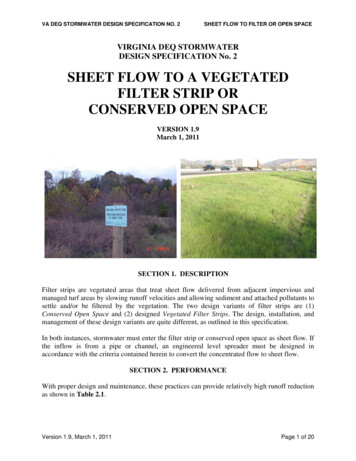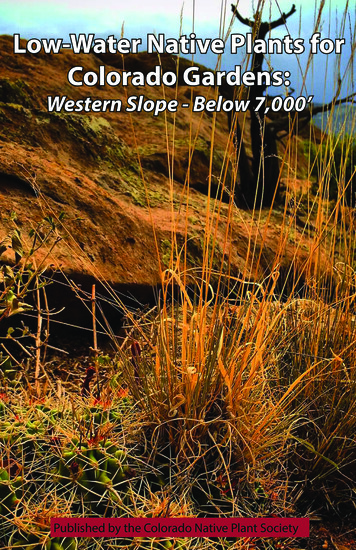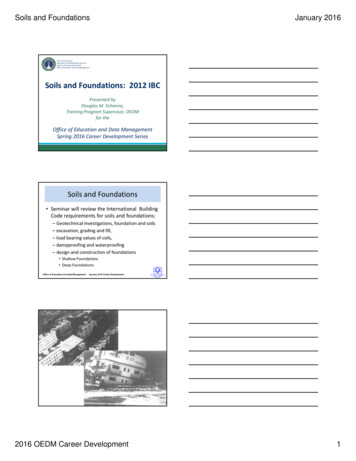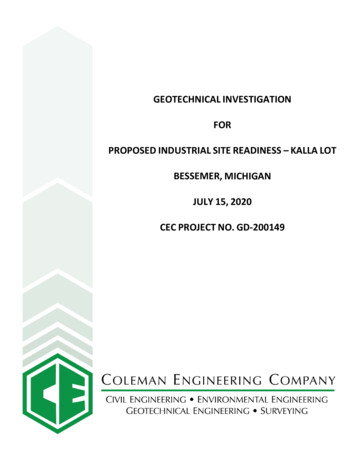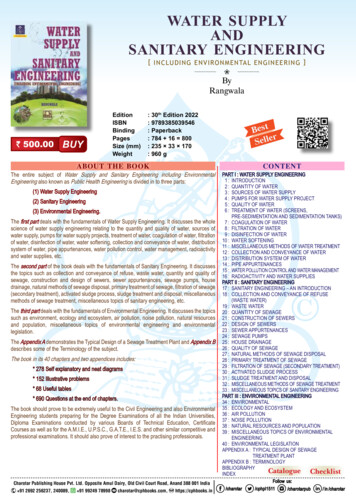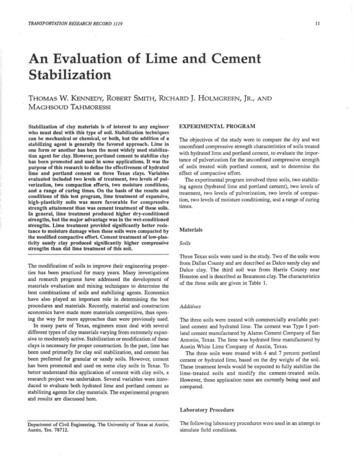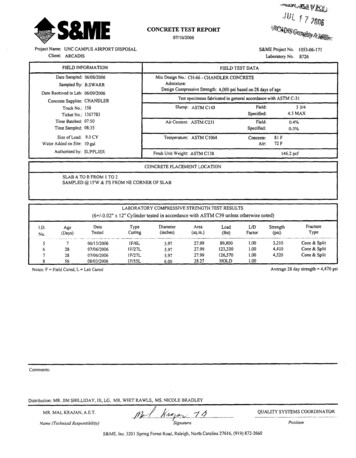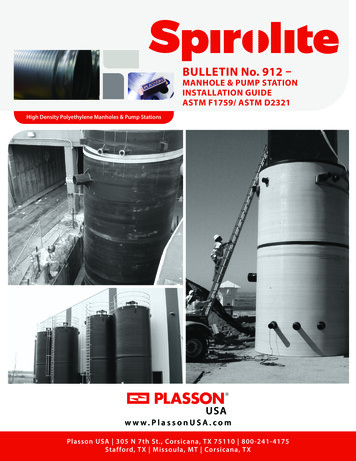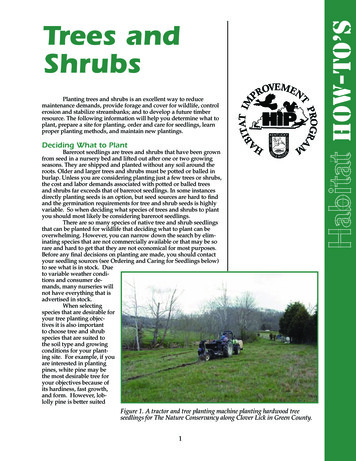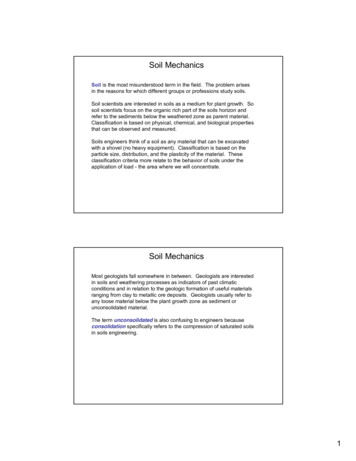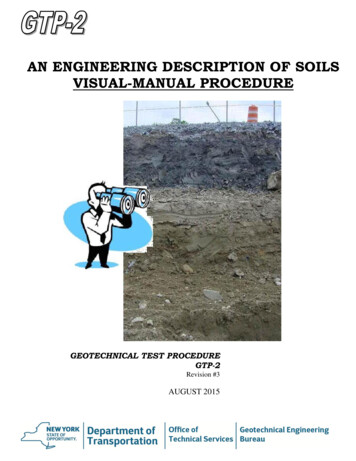
Transcription
AN ENGINEERING DESCRIPTION OF SOILSVISUAL-MANUAL PROCEDUREGEOTECHNICAL TEST PROCEDUREGTP-2Revision #3AUGUST 2015
GEOTECHNICAL TEST PROCEDURE:AN ENGINEERING DESCRIPTION OF SOILS VISUAL-MANUAL PROCEDUREGTP-2Revision #3STATE OF NEW YORKDEPARTMENT OF TRANSPORTATIONGEOTECHNICAL ENGINEERING BUREAUAUGUST 2015EB 15-025Page 1 of 13
TABLE OF CONTENTS1.INTRODUCTION.32.DEFINITION OF TERMS .43.VISUAL-MANUAL IDENTIFICATION .64.SOIL SAMPLE IDENTIFICATION PROCEDURE .95.EXAMPLES OF DESCRIPTIONS OF THE SOIL COMPONENTS .106.OTHER INFORMATION FOR DESCRIBING SOILS .117.PREPARING THE WORD PICTURE .128.TRAINING SUGGESTIONS .13EB 15-025Page 2 of 13
1. INTRODUCTIONThis manual presents a procedure for describing soil samples obtained from earth and foundationengineering purposes by the New York State Department of Transportation. The procedureinvolves visually and manually examining soil samples with respect to texture, plasticity andcolor. A method is presented for preparing a “word picture” of a sample for entering on asubsurface exploration log or other appropriate data sheet. The procedure applies to soildescriptions made in the field or laboratory.It should be understood that the soil descriptions are based upon the judgment of the individualmaking the description. Classification tests are not intended to be used to verify the description,but to provide further information for analysis of soil design problems or for possible use of thesoil as a construction material.It is the intent of this system to describe only the constituent soil sizes that have a significantinfluence on the visual appearance and behavior of the soil. This description system is intendedto provide the best word description of the sample to those involved in the planning, design,construction, and maintenance processes.EB 15-025Page 3 of 13
2. DEFINITION OF TERMSBOULDER-A rock fragment, usually rounded by weathering or abrasion, with anaverage dimension of 12 inches (305 mm) or more.COBBLE-A rock fragment, usually rounded or sub rounded, with an averagedimension between 3 and 12 inches (75 and 305 mm).GRAVEL-Rounded, sub rounded, or angular particles of rock that will pass a 3 inch(75 mm) square opening sieve and be retained on a No. 10 (2.0 mm) USstandard sieve.(The term “gravel” in this system denotes a particle size range and shouldnot be confused with “gravel” used to describe a type of geologic depositor a construction material.)SAND-Particles that will pass the No. 10 (2.0 mm) US standard sieve and beretained on the No. 200 (0.075 mm) US standard sieve.*SILT-Material passing the No. 200 (0.075 mm) US standard sieve that isnonplastic and exhibits litter or no strength when dried.*CLAY-Material passing the No. 200 (0.075 mm) US standard sieve that can bemade to exhibit plasticity (putty like property) within a wide range ofwater contents and exhibits considerable dry strength.Fines-The portion of a soil passing a No. 200 (0.075 mm) US standard sieve.MARL-Unconsolidated white or black gray calcium carbonate deposit.MUCK-Finely divided organic material containing various amounts of mineralsoil.PEAT-Organic material in various stages of decomposition.Organic CLAY-Clay containing microscopic size organic matter. May contain shellsand/or fibers.Organic SILT-Silt containing microscopic size organic matter. May contain shells and/orfibers.EB 15-025Page 4 of 13
Coarse-Grained Soil-Soil having a predominance of gravel and/or sand.Fine-Grained Soil-Soil having a predominance of silt and/or clay.Mixed-Grained Soil-Soil having significant proportions of both fine-grained and coarsegrained sizes.*Note-EB 15-025When applied to gradation tests results, silt size is defined as that portionof the soil finer than the No. 200 (0.075 mm) US standard sieve andcoarser than 0.00008 in. (0.002 mm). Clay size is that portion of the soilfiner than 0.00008 in. (0.002 mm). For the visual-manual procedure theidentification will be based on plasticity characteristics.Page 5 of 13
3. VISUAL-MANUAL IDENTIFICATIONGRAVEL-Identified by particle size. The particles may have an angular, rounded, orsub rounded shape. Gravel size particles usually occur in varyingcombinations with other particle sizes.SAND-Identified by particle size. Gritty grains that can easily be seen and felt. Noplasticity or cohesion. Size ranges between gravel and silt.SILT-Identified by behavior. Fines that have no plasticity. May be rolled into athread but will easily crumble. Has no cohesion. When dry, can be easilybroken by hand into powdery form.CLAY-Identified by behavior. Fines that are plastic and cohesive when in a moistor wet state. Can be rolled into a thin thread that will not crumble. Whendry, forms hard lumps which cannot be readily broken by hand.Clay is often encountered in combination with other soil sizes. If a sampleexhibits plasticity or cohesion, it contains clay. The amount of clay can berelated to the degree of plasticity or cohesiveness; the higher the claycontent the greater the plasticity.MARL-A white or gray calcium carbonate paste. May contain granular spheres,shells, organic material or inorganic soils. Reacts with weak hydrochloricacid.MUCK-Black or dark brown finely divided organic material mixed with variousproportions of sand, silt, and clay. May contain minor amounts of fibrousmaterial such as roots, leaves, and sedges.PEAT-Black or dark brown plant remains. The visible plant remains range fromcoarse fibers to finely divided organic material.Organic CLAY-Dark gray clay with microscopic size organic material dispersedthroughout. May contain shells and/or fibers. Has weak structure whichexhibits little resistance to kneading.Organic SILT-Dark gray silt with microscopic size organic material dispersedthroughout. May contain shells and/or fibers. Has weak structure whichexhibits little resistance to kneading.Fill-Man-made deposits of natural soils and/or waste materials. Document thecomponents carefully since presence and depth of fill are importantengineering considerations.EB 15-025Page 6 of 13
PARTICLE SIZEEXAMPLES OF PARTICLE SHAPESEB 15-025Page 7 of 13
IDENTIFICATION PROCEDURE CHARTCOARSE-GRAINED SOILS(Identify by Size of Particles)BOULDERSGreater Than 12”(305 mm)COBBLES12” to 3”(305 mm to 75mm)GRAVEL3” to No.10COARSE3” to 1”(75 mm to 25 mm)FINE1” to No. 10(25 mm to 2.0 mm)SANDNo.10 to No. 200COARSENo. 10 to No. 40(2.0 mm to 0.425 mm)FINENo. 4 to No. 200(0.425 mm to 0.075 mm)FINE-GRAINED SOILSIdentify by Behavior(Individual Particles Not Visible)1.2.3.4.5.SILTNonplastic.Powders easily when dry.Dries rapidly.Free water appears when shaken.Wire cut surface – rough.1.2.3.4.5.CLAYPlastic, acts like putty when moist and wet.High dry strength.Dries slowly – sticky.No free water when shaken.Wire cut surface – smooth.MIXED-GRAINED SOILSSignificant proportions of coarse-grainedand fine-grained sizes. Make judgment onwhether fine-grained or coarse-grainedpredominates in behavior.ORGANIC SOILS(Identify by Appearance, Behavior, Color, etc.)PEATEB 15-025MUCKMARLPage 8 of 13ORGANICSILTORGANICCLAY
4. SOIL SAMPLE IDENTIFICATION PROCEDURE1st DecisionIs sample coarse-grained, fine-grained, mixed-grained, or organic?If mixed-grained, decide whether coarse-grained or fine-grained predominates.2nd Decision*What is principal component?Use as noun in soil description.Example: SAND3rd Decision*What is secondary component?Use as adjective in soil description.Example: Silty SAND4th Decision*Are there additional components?Use as additional adjective.Example: Silty, SAND, Gravelly*The principal component is to be written in all capital letters; the color and all othercomponents have only the first letter written in capitals. The apparent moisture and plasticityabbreviations are written in all capital letters.e.g. Brown Silty, SAND, Gravelly M-NPLEB 15-025Page 9 of 13
5. EXAMPLES OF DESCRIPTIONS OF THE SOIL COMPONENTSSAND-Describes a sample that consists of both fine and coarse sand particles.GRAVEL-Describes a sample that consists of both fine and coarse gravel particles.Silty Fine SAND-Major component fine sand, with nonplastic fines.Sandy GRAVEL-Major component gravel size, with fine and coarse sand. May containsmall amount of fines.Gravelly SAND-Major component sand, with gravel. May contain small amount of fines.Gravelly SAND, Silty-Major component sand, with gravel and nonplastic fines.Gravelly SAND, Clayey-Major component sand, with gravel and plastic fines.Sandy GRAVEL, Silty-Major component gravel size, with sand and nonplastic fines.Sandy GRAVEL, Clayey-Major component gravel size, with sand and plastic fines.Silty GRAVEL-Major component gravel size, with nonplastic fines. May contain sand.Clayey GRAVEL-Major component gravel size, with plastic fines. May contain sand and silt.Clayey SILT-Major component silt size, with nonplastic fines. May contain sand andsilt.Silty CLAY-Major component clay, with silt size. Higher degree of plasticity andhigher dry strength than clayey silt.The above system may be expanded where necessary to provide meaningful descriptions of thesample.Examples:Shale fragments – Cobble and gravel size, silty.Decomposed rock – Gravel size.EB 15-025Page 10 of 13
6. OTHER INFORMATION FOR DESCRIBING SOILS1.COLOR OF THE SAMPLE:Brown, Gray, Red, Black, etc.2.MOISTURE CONDITION:Dry (D), Moist (M), Wet (W).Judge by appearance of sample before manipulating.3.PLASTICITY:Plastic (P), Low Plastic (LPL), Nonplastic (NP).Note: Sample must be in moist or we condition forplasticity determination. For dry samples requiringwetting make note in description. Example: “plastic(low or nonplastic) when wet”.Plasticity not required for marl, muck and peat.4.STRUCTURE:Fissured, Blocky, Varved, Layered. (Indicate approximatethickness of layers). The description of layering for coarsegrained soils must be made from field observations beforesample is removed from sampler.5.PARTICLE SIZE:Angular, Rounded, Sub rounded.6.Other words, phrases, notes or remarks that will add to the meaningfulness of thecomplete soil description.EB 15-025Page 11 of 13
7. PREPARING THE WORD PICTUREThe word-picture is the description of the soil sample as determined by the visual-manualprocedure. Where applicable, the following are to be included in the word picture:PERTINENT INFORMATION1. Color of the sample2. Description of Soil Components3. Moisture Condition4. Plasticity5. Structure6. Particle shape7. OtherThe written description for the given example is: Brownnonplastic, cemented.EXAMPLEBrownSilty GRAVELmoistnonplasticangularcementedSilty angular GRAVEL, moist,EXAMPLES OF COMPLETE SOIL DESCRIPTIONSLight Gray Silty CLAY, moist, plastic with ½ inch layers of wet, Gray SILT, nonplastic.Red Brown Clayey SILT with ¼ inch layers of Silty CLAY, moist plastic.Brown Silty Fine SAND, wet, nonplastic.Gray Sandy rounded GRAVEL, dry, nonplastic.Gray Sandy angular GRAVEL, Clayey, moist, low plastic.Dark Brown Silty SAND, wet, nonplastic.Red Brown SAND, dry, nonplastic, with roots.Fill- Brown Sandy sub rounded GRAVEL, with pieces of brick and cinders, wet, nonplastic.Fill containing cinders, paper, garbage, and glass, wet.Dark Gray Organic CLAY, with shells and roots, moist, plastic.Light Brown SAND, wet, nonplastic.Gray Clayey SAND with angular Gravel, moist, low plastic.Black Sandy MUCK, wet.Dark Brown fibrous PEAT, wet.Dark Brown PEAT, wet.EB 15-025Page 12 of 13
8. TRAINING SUGGESTIONSThe following sequence is suggested for training personnel in the use of the system:1.Learn definition of terms (pages 4 and 5).2.Provide individual samples of gravel, sand, and silt and clay. Include complete rangeof sizes for gravel and sand. This allows visual calibration of size limits of coarsegrained soils and experience in identifying fine-grained soils by behavior. Refer tovisual-manual identification (pages 6 and 7) and Identification Procedure (pages 8 and9).3.Provide coarse-grained and fine-grained samples to practice identification anddescription of soil components.4.Provide mixed-grained samples for identification and procedure.5.Provide organic soils for description.EB 15-025Page 13 of 13
EB 15-025 Page 5 of 13 Coarse-Grained Soil-Soil having a predominance of gravel and/or sand.Fine-Grained Soil-Soil having a predominance of silt and/or clay.Mixed-Grained Soil-Soil having significant proportions of both fine-grained and coarse-grained sizes. *Note- When applied to gradation tests results, silt size is defined as that portion
